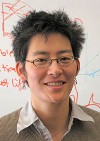Lena Ting
Associate Professor

- Office:
- BME 3105
- Phone:
- 404-894-5216
- Email:
- lena [dot] ting [at] bme [dot] gatech [dot] edu
Biography
As an undergraduate in mechanical engineering, I thought robotics could help us understand how animals move. I worked in a zoology lab studying the biomechanics of cockroach locomotion where I measured the forces generated during cockroach running and computed the moments generated. It was fun, but I didn't think that cockroach running was all that relevant or interesting. After taking a year off to finish up research projects and to travel, went to graduate school to learn human musculoskeletal modeling. But my thesis was entirely experimental because the muscle activation patterns I measured during human pedaling changed independent of the mechanical state of the limb, so the model couldn't help me interpret my data. Instead, I had to understand the neural control aspect. Convinced I couldn't do this in humans, I did two postdoctoral fellowships (one in Paris) to become a neurophysiologist, working in an animal model. Which was great, but I realized I still couldn't get all the information I wanted from animals, either. In the meantime, my cockroach research was inspiring new developments in legged robots, and my human research was giving physical therapists insights into treating spinal cord injury. Today, my research groups incorporates aspects from all of my prior research experiences to study the neuromechanics of movement; we study healthy and impaired animals and humans, using experimental, computational, and robotic approaches!
My research focus is in neuromechanics of muscle coordination for locomotion and balance. Using a combination of musculoskeletal modeling and behavioral experiments in humans and animals, I study interactions between neural sensorimotor systems and musculoskeletal biomechanics. The goal is to reveal general principles of muscle coordination for walking, with implications for rehabilitation and robotics.
I am interested in humans and animals are able to perform coordinated movements so elegantly. I am interested in developing conceptual frameworks in neuromechanics to quantify how human cognition and perception influence muscle coordination and biomechanics to produce skilled movements. Ultimately I hope to unravel how each individual unique social, cultural, and biological influences shape how they move.
My research has implications for physical therapy and rehabilitation, as well as the development of prosthetics. Graduate students from my lab have gone on to work in academia, doing postdoctoral research in the areas of rehabilitation and prosthetic research, and in industry, working in surgical robotics, biomechanics and accident reconstruction. Others have used their quantitative and modeling skills towards careers in the management consulting, aeronautics and oil industries.
